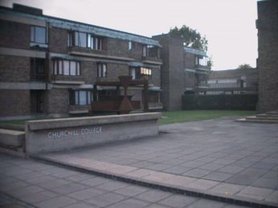Churchill College, Cambridge
|
|
Template:Oxbridge College Infobox
Churchill College is one of the constituent colleges of the University of Cambridge and was founded in 1960 as the national and commonwealth memorial to Winston Churchill.
Churchill is situated on the outskirts of the town away from the traditional centre of old Cambridge, but close to the University's main new development zone. Its 40 acres (160,000 m²) of grounds make it the physically largest of all the colleges.
Churchill was one of the first three men's colleges to admit women in 1972; the others were Kings and Clare. Within 15 years all others had followed suit.
Cambridge University Radio is broadcast from Churchill College.
| Contents |
History
In 1955, on holiday in Sicily soon after his resignation as Prime Minister, Winston Churchill discussed with Sir John Colville and Lord Cherwell the possibility of founding a new institution. Churchill had been impressed by MIT and wanted a British version, but the plans evolved to the more modest proposal of creating a Scientific and Technological based college within the University of Cambridge. Churchill wanted a mix of non-scientists to ensure a well rounded education and environment for scholars and fellows.
The bias to science and engineering remains as policy to the current day, with a general aim of a ratio of 3 technology students to 1 arts student amongst the college population.
Buildings
The college's central buildings were designed by Richard Sheppard, and built on the 42 acre (170,000 m²) west Cambridge site through the purchase of a farm between 1958 and the college's opening two years later.
In the centre of the college is the Churchill Archive Centre opened in 1974 to provide a home to Sir Winston's papers, and also more recently endowed with papers from former Prime Minister Margaret Thatcher.
In 1992, the Møller Centre for Continuing Education was built in the gardens, designed by Henning Larsen.
At the farthest end of the college is Churchill College Chapel. The idea of a having a religious building within a modern, scientifically-oriented, academic institution deeply annoyed some of the original fellows, reputedly leading to the resignation of Nobel Prize winner Francis Crick in protest. Eventually a compromise was found: the chapel was sited away from the other buildings, and funded and managed separately from the rest of the College itself, being tactfully referred as "the Chapel at Churchill College".
According to the anecdote, Crick had agreed to become a fellow on the basis that no chapel be placed in Churchill. A donation was later made to Churchill College for the establishment of one, and the majority of fellows voted for it. Winston Churchill reputedly wrote to Crick, saying that no-one need enter the chapel except under free will so it need not be a problem. Crick, in short order, replied with a letter containing 10 guineas saying that if that were the case, here were 10 guineas for the establishment of a brothel.
Masters
The Mastership of the College is a Crown appointment. To date the College has had five Masters:
- Sir John Cockcroft, (Master 1959–67), Nobel Laureate in Physics, who split the atom.
- Sir William Hawthorne (Master 1968–83), who helped develop the jet engine.
- Sir Hermann Bondi (Master 1983–90), cosmologist who helped develop the Steady State theory of the universe.
- Sir Alec Broers (Master 1990–96), nanotechnologist (left to become Vice-Chancellor, University of Cambridge)
- Sir John Boyd (Master 1996–), formerly British ambassador to Japan, 1992–96
Ents
Every week of the Michaelmas and Lent terms, Churchill is host to The Pav, a weekly music event unusual for Cambridge events in that it is free and open to all university members. (The name Pav originates from the pavilion buildings of the college where the event was traditionally held. In recent years however, the pav has been held in the main bar area.)
While many older colleges hold balls in May Week, Churchill holds a Spring Ball every February. Past themes have included Showdown (2005), Arabian Nights (2004), Hakuna Matata (2003) and Ocean Bound (2002).
During May Week the college JCR organise a free garden party.
Churchill College JCR
All undergraduate members of Churchill College are automatically members of the Churchill College JCR. The JCR represents undergraduates in various college meetings. The JCR elect members annually to the 15 posts of the JCR committee. These posts are:
- President
- Secretary
- Treasurer
- Access and Academic Affairs Officer
- Environment and Ethics Officer
- Winston Editor—Winston is Churchill College JCR's free fortnightly publication
- Equipment and Communications Officer
- International Officer
- External Officer
- Webmaster
- Ents (affectionately known as Entsmaster)
- LBGT Officer
- Women's Welfare Officer
- Men's Welfare Officers
Members can opt out of the JCR if they wish, but this is rarely done.
In recent times the Churchill JCR has been unable to keep a functioning television, as a result of repeated acts of wanton vandalism.
Art
The college contains many examples of artwork including pieces by Andy Warhol, Anthony Caro and Dame Barbara Hepworth.
Churchill_College,_Hepworth.jpg
Notable Alumni
Mike Gascoyne - Toyota Formula One Technical Director
Ian Stewart - Mathematician
External links
- College Website (http://www.chu.cam.ac.uk/)
- Churchill College JCR (http://jcr.chu.cam.ac.uk/)
- Archive Centre (http://www.chu.cam.ac.uk/archives)
- Churchill College Spring Ball (http://www.springball.com/)
| Colleges of the University of Cambridge | 
|
|---|---|
|
Christ's | Churchill | Clare | Clare Hall | Corpus Christi | Darwin | Downing | Emmanuel | Fitzwilliam | Girton | Gonville and Caius | Homerton | Hughes Hall | Jesus | King's | Lucy Cavendish | Magdalene | New Hall | Newnham | Pembroke | Peterhouse | Queens' | Robinson | St Catharine's | St Edmund's | St John's | Selwyn | Sidney Sussex | Trinity | Trinity Hall | Wolfson | |

